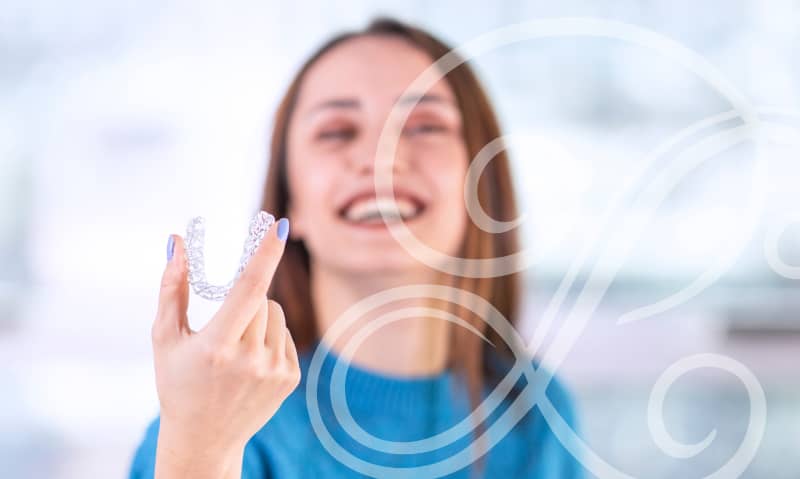Invisalign is Used to Correct Mild to Moderate Overbite

Fixing Overbites with Invisalign
Invisalign is a great way for teens and adults to go through orthodontic treatment without drastically changing their appearance or lifestyle. Not only are Invisalign’s clear aligners subtle, but they’re also extremely effective at straightening teeth. The average Invisalign treatment plan takes 12 to 18 months, while a comparable plan using traditional braces may take two years or more.
Invisalign is also capable of treating a broad range of bite alignment or malocclusion issues, including mild to moderate overbites.
What are overbites and malocclusions, and why do they happen?
The term ‘malocclusion’ is one you’ll frequently hear when discussing orthodontic care. A malocclusion is a condition in which a person’s upper and lower teeth have an abnormal alignment. It could be caused by a specific bite issue, like an overbite, or from crooked or crowded teeth.
Malocclusions are categorized into three classes:
- Class I: Abnormal or crossbite caused by crowded, crooked, or rotated teeth.
- Class II: Mild to moderate overbites (Division 1) and deep overbites (Division 2)
- Class III: Underbites
Overbites are characterized by a person’s upper teeth overhanging their lower teeth. In Class II Division 1 cases, the overbite’s appearance is caused by the teeth tilting or jutting outward. In a Class II Division 2 case, the overbite is caused by a person’s jaw structure being positioned too far forward. This is also called an overjet.
Overbites can be caused by several factors, including:
- Dental problems
- Overdeveloped upper jaw
- Underdeveloped lower jaw
- Behavioral habits (i.e., thumbsucking, pacifier use)
- Genetics
Division 1 overbites tend to respond very well to orthodontic care, while Division 2 may require a more lengthy, complicated treatment process to adjust the placement of the upper jaw. Invisalign can fix overbites in the Division 1 category, but severe Division 1 and nearly all Division 2 cases will require traditional wire braces.
How can Invisalign treat mild to moderate overbites?
Invisalign clear aligners aren’t quite as simple as they first appear. The technology behind their design and the addition of orthodontic accessories make Invisalign capable of treating Class II malocclusions that other clear aligner systems can’t.
After evaluating your malocclusion and determining you’re a candidate for Invisalign, your dentist will digitally map out your smile with an iTero scanner. The information from the scan will be used with Invisalign software to predict your treatment plan and design each clear aligner tray to make up a customized set.
Because treating an overbite is a bit more complicated than a few crooked teeth, your dentist may also include Invisalign accessories or attachments. SmartForce attachments are tiny tooth-colored nubs placed on the teeth to give the clear aligners something to grip. Your aligner will also have precision wings to gently but effectively push the jaw forward—this is also known as mandibular advancement. Similar to traditional braces, Invisalign aligners employ special elastic bands to help create additional force in straightening teeth.
Will Invisalign permanently fix my overbite?
The results from Invisalign are permanent, but only if you follow your dentist’s instructions on wearing a retainer. Like traditional braces, you must wear a retainer after Invisalign treatment to prevent the teeth from shifting back to their previous positions. Skipping proper retainer-wearing habits can gradually reverse your results, causing your teeth to develop an overbite again.
Teeth can revert back to their previous positions because of what’s happening with your jawbone during orthodontic care. As your teeth move, the bone must also redevelop around each tooth, but orthodontic care moves your teeth faster than it takes the bone to repair itself. Therefore, wearing a retainer daily for 6 to 12 months keeps the teeth in place while the bone finishes healing around the repositioned tooth roots.
Eventually, you won’t need to wear your retainer every day, but it’s highly recommended you always wear it at night while sleeping. It’s also a good idea to pop it in during the day a few times a week, like days when you’re relaxing at home.
Correct your overbite with Invisalign at Parmer Lane Family Dentistry
Parmer Lane Family Dentistry provides the best general and cosmetic dentistry in Austin, TX. Invisalign is one of our most popular cosmetic dentistry services for anyone who wants a healthier, straighter smile.
If you have an overbite and are interested in Invisalign, the first step is to schedule a consultation. After evaluating your bite and thoroughly examining your smile, your dentist will let you know if you’re an ideal candidate for Invisalign treatment.
Schedule your Invisalign consultation today by calling our office or requesting a visit online.